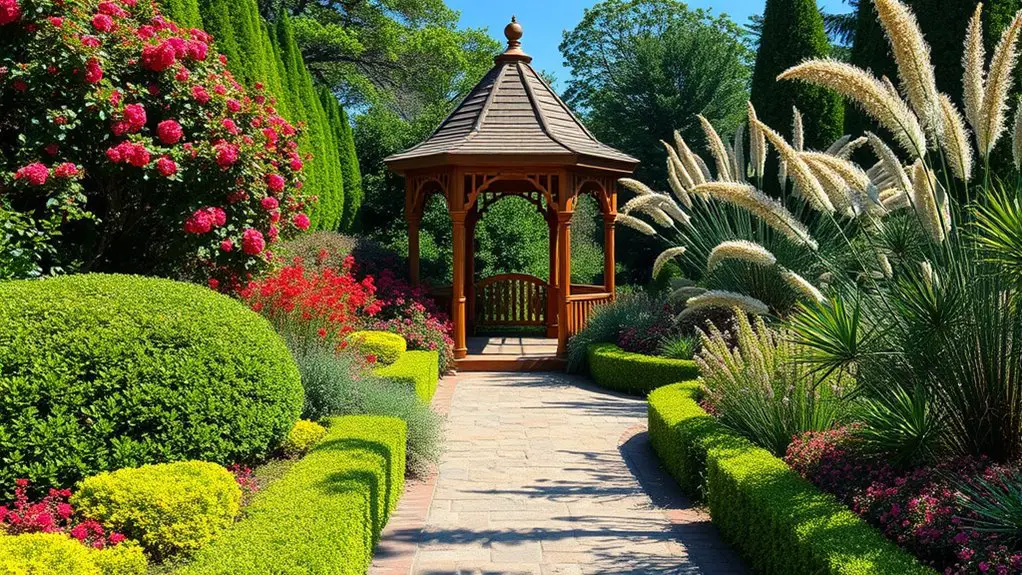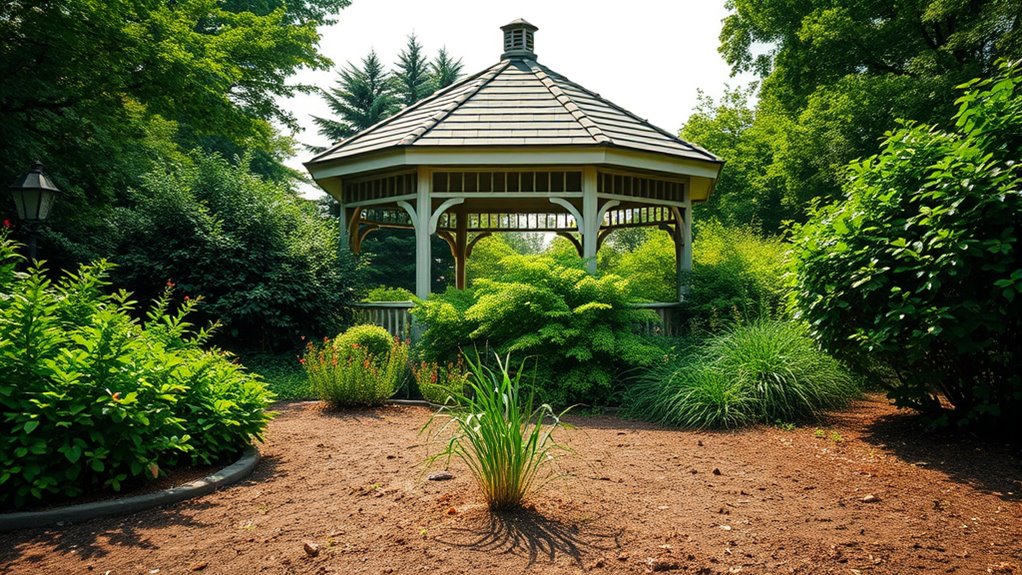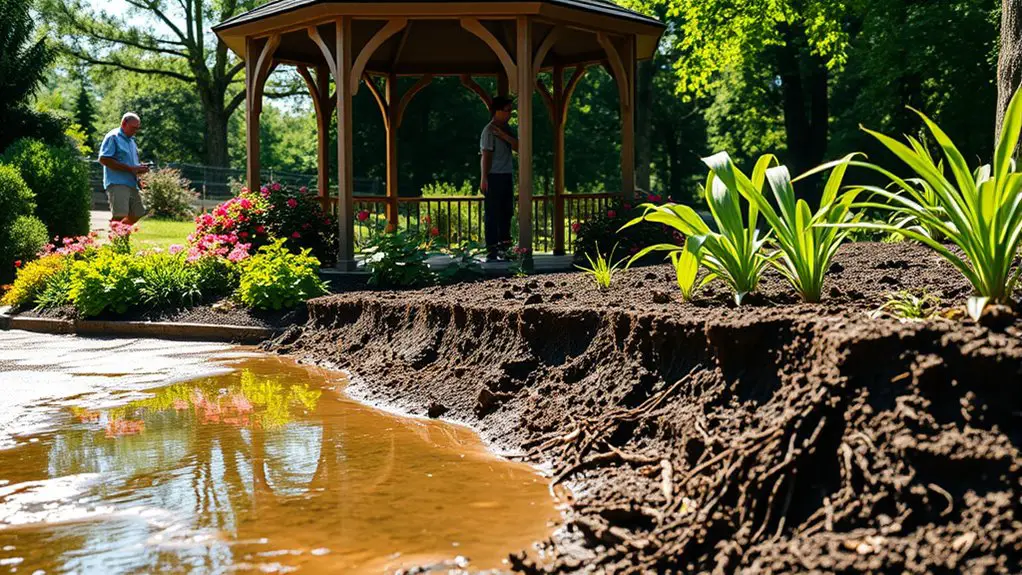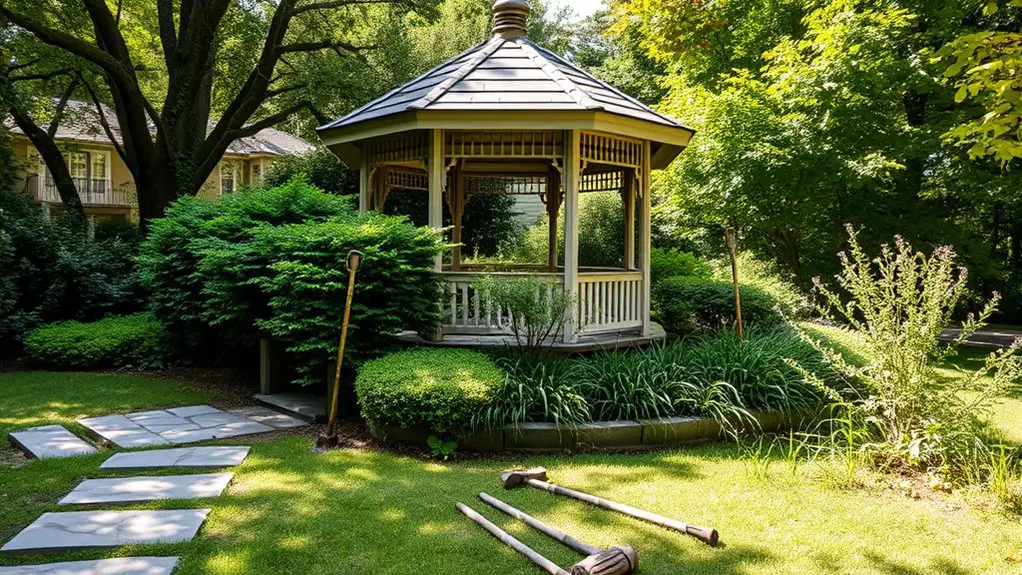When landscaping around your gazebo, don’t ignore scale and proportion; a gazebo should harmonize with nearby plants and structures. Avoid choosing incompatible plant species that won’t thrive in your local conditions. Remember to take into account seasonal interest for year-round appeal. Neglecting proper drainage can lead to water issues, while poor lighting design may diminish functionality. Finally, make certain your pathways are clear and inviting. Discover more about creating an exquisite outdoor space that complements your gazebo.
Ignoring Scale and Proportion

When you’re designing the landscape around your gazebo, it’s easy to overlook the importance of scale and proportion. Ignoring these elements can disrupt the visual appeal and functionality of your space. To create a sense of scale balance, consider the size of your gazebo in relation to nearby plants and structures. For instance, towering trees can overshadow a modest gazebo, while tiny flowers might feel lost in its presence.
Achieving proportion harmony means selecting plants that complement the gazebo’s dimensions. Choose larger shrubs to frame the structure, and smaller perennials to create layers that draw the eye upward. Paths leading to your gazebo should also be proportional; a wide, sweeping walkway can enhance the grandeur, while a narrow path may feel cramped. By thoughtfully considering scale and proportion, you’ll create a landscape that feels open, inviting, and beautifully balanced around your gazebo.
Choosing Incompatible Plant Species
When you’re picking plants for around your gazebo, it’s essential to think about how well they’ll thrive in your local climate. Choosing species that have different growth requirements can lead to a patchy, uninviting landscape that detracts from your outdoor space. By evaluating climate compatibility and considering each plant’s needs, you can create a harmonious garden that enhances your gazebo’s beauty.
Assess Climate Compatibility
Although it might be tempting to choose vibrant plants that catch your eye, overlooking climate compatibility can lead to a landscape that struggles to thrive. Each plant has its unique needs, influenced by your specific climate zone and local weather patterns. If you pick species that can’t handle your area’s temperature extremes or humidity, you’re setting yourself up for disappointment. For example, tropical plants may look stunning but will wilt in colder regions. Instead, research plants that flourish in your climate zone, ensuring they can withstand the seasonal changes. This thoughtful approach not only saves you time and effort but also allows your gazebo to shine in a flourishing, harmonious garden that reflects your personal style and freedom.
Consider Growth Requirements
Choosing the right plants for your gazebo isn’t just about climate; it also involves understanding their growth requirements. If you plant species that don’t match your soil type, you’re setting yourself up for failure. For instance, some plants thrive in sandy soil while others prefer clay. Consider the plant height too; towering plants can overshadow your gazebo, stealing its charm. Balance is key—mix shorter flowers with mid-height shrubs to create a layered look that complements your structure. Additionally, be mindful of how plants spread. If you choose invasive species, they could overwhelm your space and ruin the aesthetic you desire. By carefully selecting compatible plants, you’ll enjoy a harmonious landscape that enhances your gazebo’s beauty and your outdoor freedom.
Overlooking Seasonal Interest

When landscaping around your gazebo, it’s easy to forget about the changing seasons and how they can transform your space. Selecting plants that offer year-round interest can keep your outdoor retreat vibrant and inviting, no matter the month. By incorporating seasonal color and creating focal points, you’ll guarantee your gazebo remains an enthralling centerpiece throughout the year.
Year-Round Plant Selection
While selecting plants for landscaping around a gazebo, it’s easy to focus solely on vibrant blooms or lush greenery for the warmer months, but overlooking seasonal interest can lead to a lackluster garden year-round. To create a lively outdoor space that captivates through every season, consider integrating a mix of native plants and evergreen shrubs. These additions not only thrive in your local environment but also provide texture and contrast throughout the year.
- Incorporate winter-blooming perennials for unexpected color.
- Choose evergreen shrubs for year-round structure.
- Select flowering plants that offer staggered bloom times.
- Add ornamental grasses for movement and interest.
- Plan for fall foliage to extend your visual appeal.
With thoughtful selection, your gazebo’s landscape can flourish in every season.
Seasonal Color Considerations
Many homeowners underestimate the importance of seasonal color when landscaping around a gazebo, often resulting in a garden that feels dull or uninviting during off-peak months. To create a vibrant space, think about incorporating plants that offer seasonal blooms, ensuring your garden evolves beautifully throughout the year. Choose color palettes that complement your gazebo and the surrounding environment, mixing perennials for consistency and annuals for that burst of quick color. For spring, opt for tulips and daffodils; in summer, consider vibrant zinnias. Don’t forget about fall’s rich hues with asters and ornamental grasses. By planning for year-round interest, you’ll enjoy a lively, inviting atmosphere, allowing your gazebo to shine in every season.
Focal Points for Interest
Creating a vibrant landscape around your gazebo goes beyond just considering seasonal color; it’s also about establishing focal points that captivate the eye and enhance the overall aesthetic. You’ll want to guarantee your focal point placement creates visual balance, drawing the viewer’s attention without overwhelming the space.
- Use a striking sculpture or art piece as a centerpiece.
- Introduce a vibrant flower bed that changes with the seasons.
- Incorporate decorative lighting to highlight features at night.
- Consider a unique tree or shrub that offers year-round interest.
- Add a water feature, such as a small fountain, for sound and movement.
Neglecting Proper Drainage

When you’re landscaping around a gazebo, overlooking proper drainage can lead to a host of problems that might dampen your outdoor retreat. Without effective water management, rainwater could pool around your gazebo, causing damage to the structure and muddying your landscape. You don’t want to spend your weekends dealing with soggy soil and invasive weeds.
To avoid these issues, consider smart drainage solutions like installing French drains or grading the landscape to direct water away. Incorporate permeable materials for walkways, allowing rain to seep through rather than run off. This way, you’re not only protecting your gazebo but also enhancing the beauty of your garden.
Skipping Thoughtful Lighting Design
While it might be tempting to focus solely on plants and hardscapes, skipping thoughtful lighting design can dim the charm of your gazebo and surrounding landscape. By incorporating ambient lighting, you can create a warm and inviting atmosphere, perfect for evening gatherings. Consider using various fixtures to highlight accent features, making your outdoor space come alive at night.
- Use string lights for a whimsical touch.
- Install solar path lights to guide guests safely.
- Highlight your gazebo with spotlights or lanterns.
- Choose warm-toned bulbs to enhance the cozy vibe.
- Incorporate dimmers for adjustable brightness.
Additionally, choosing energy-efficient designs can help reduce electricity costs while providing beautiful illumination. Don’t underestimate how lighting can transform your gazebo into a magical retreat. Thoughtful design not only enhances beauty but also extends usability. With the right illumination, your outdoor oasis can be a mesmerizing sanctuary, inviting you and your guests to relish in nature’s embrace long after the sun sets.
Failing to Create Functional Pathways
If you overlook the importance of functional pathways, your beautifully landscaped gazebo could end up feeling isolated and difficult to access. Creating clear, inviting paths not only enhances your outdoor space but also guarantees ease of movement. Think about the pathway materials you’ll use—gravel, bricks, or stepping stones all offer unique aesthetics and durability.
Consider the appropriate pathway width; a narrow path can feel cramped, while a wider one invites exploration. Here’s a quick guide to help you decide:
| Pathway Material | Ideal Width |
|---|---|
| Gravel | 3-4 feet |
| Pavers | 4-5 feet |
| Natural Stone | 3-5 feet |
Frequently Asked Questions
How Can I Enhance Privacy Around My Gazebo?
Think of your gazebo as a cozy nest; to enhance privacy, explore various fencing options like trellises or lattice. Pair them with thoughtful plant selection—evergreens or flowering shrubs—to create a natural, inviting barrier.
What Materials Are Best for Gazebo Landscaping?
For gazebo landscaping, consider well-draining soil types and choose plants that thrive in your climate. Native species often require less maintenance, providing a natural look while ensuring your space feels inviting and free.
Can I Incorporate Edible Plants Into My Landscape?
Absolutely, you can incorporate edible landscaping! Consider companion planting for a vibrant garden. Mixing herbs with flowers not only enhances beauty but also encourages beneficial insects, creating a harmonious space that fulfills your desire for freedom and sustainability.
How Do I Maintain My Landscaping Throughout the Year?
Think of your landscape as a vintage car—it needs regular tune-ups. For seasonal maintenance, check soil health, prune plants, and refresh mulch. Consistent care keeps your outdoor space thriving, giving you the freedom to enjoy it.
What Styles of Landscaping Complement Different Gazebo Designs?
When choosing landscaping for your gazebo, contemporary designs thrive with sleek lines and minimalist plants, while rustic themes benefit from wildflowers and natural stone. Balance your choice to create a harmonious outdoor retreat that reflects your style.

